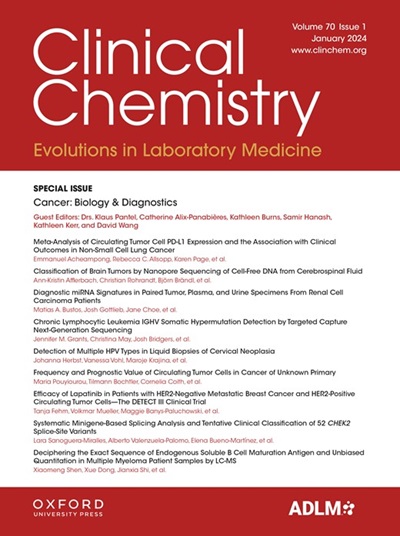Instrument Multiplexing: Amplified Throughput for Measurement of Vitamin B1 in Whole Blood Using Parallel Liquid Chromatography Systems Interfaced to a Single Mass Spectrometer
IF 7.1
2区 医学
Q1 MEDICAL LABORATORY TECHNOLOGY
引用次数: 0
Abstract
Background Thiamine diphosphate (TDP), the active form of vitamin B1, plays an essential role in energy metabolism. TDP is analyzed in the clinical laboratory to assess the nutritional status of individuals at risk of deficiency. In recent years, demand for vitamin B1 testing has increased dramatically, prompting implementation of a high-throughput assay. We developed a method using rapid sample preparation and multiplex electrospray LC-MS/MS analysis. Methods Whole blood samples were deproteinized using trichloroacetic acid after the addition of isotope-labeled analyte (TDP-d3). TDP was separated by reversed-phase chromatography on extended pH, trifunctional silane-bonded C18 columns and analyzed using positive electrospray ionization and multiple reaction monitoring mass spectrometry. The system consisted of 4 LC instruments plumbed to a single mass spectrometer. TDP eluted in 3.15 ± 0.08 min with a run time of 9.0 min for a single stream; results for 4 streams were produced every 2.25 min. Passivation of the system was required to optimize sensitivity and peak quality. Results The method was linear from 20 to 1000 nmol/L. Spike-recovery experiments showed an accuracy of ±15%. The intra- and inter-day assay imprecision was ≤3%. Repeated injections of calibrators and QC materials across the four LC streams showed excellent parity (<2% imprecision). No carryover was detected. Each plate produced 81 results in 4.5 h. Conclusions An accurate, specific, and high-throughput LC-MS/MS method was developed and validated to measure TDP in whole blood. Simple, fast sample preparation was employed for adaptation to a staggered injection, multiple LC-stream platform, which minimized mass spectrometer idle time significantly and improved efficiency.仪器多路复用:利用平行液相色谱系统与单质谱联用,用于全血中维生素B1的放大通量测量
硫胺素二磷酸(TDP)是维生素B1的活性形式,在能量代谢中起重要作用。临床实验室对TDP进行分析,以评估有缺乏风险的个体的营养状况。近年来,对维生素B1检测的需求急剧增加,促使高通量分析的实施。我们开发了一种快速样品制备和多重电喷雾LC-MS/MS分析的方法。方法全血标本加入同位素标记物(TDP-d3)后,采用三氯乙酸脱蛋白。TDP采用扩展pH、三功能硅烷键合C18色谱柱反相色谱分离,采用正电喷雾电离和多重反应监测质谱分析。该系统由4个LC仪器组成,连接到一个质谱仪上。TDP洗脱时间为3.15±0.08 min,单流运行时间为9.0 min;每2.25分钟产生4个流的结果。需要对系统进行钝化以优化灵敏度和峰质量。结果该方法在20 ~ 1000 nmol/L范围内线性良好。峰回收率实验的准确度为±15%。日内和日间测定不精密度≤3%。在四个LC流中反复注入校准器和QC材料显示出极好的奇偶性(<;2%的不精度)。未检测到结转。建立了一种准确、特异、高通量的LC-MS/MS测定全血TDP的方法,并通过验证。采用简单、快速的样品制备方法,适应了交错进样、多LC-stream平台,大大减少了质谱仪的空闲时间,提高了效率。
本文章由计算机程序翻译,如有差异,请以英文原文为准。
求助全文
约1分钟内获得全文
求助全文
来源期刊

Clinical chemistry
医学-医学实验技术
CiteScore
11.30
自引率
4.30%
发文量
212
审稿时长
1.7 months
期刊介绍:
Clinical Chemistry is a peer-reviewed scientific journal that is the premier publication for the science and practice of clinical laboratory medicine. It was established in 1955 and is associated with the Association for Diagnostics & Laboratory Medicine (ADLM).
The journal focuses on laboratory diagnosis and management of patients, and has expanded to include other clinical laboratory disciplines such as genomics, hematology, microbiology, and toxicology. It also publishes articles relevant to clinical specialties including cardiology, endocrinology, gastroenterology, genetics, immunology, infectious diseases, maternal-fetal medicine, neurology, nutrition, oncology, and pediatrics.
In addition to original research, editorials, and reviews, Clinical Chemistry features recurring sections such as clinical case studies, perspectives, podcasts, and Q&A articles. It has the highest impact factor among journals of clinical chemistry, laboratory medicine, pathology, analytical chemistry, transfusion medicine, and clinical microbiology.
The journal is indexed in databases such as MEDLINE and Web of Science.
 求助内容:
求助内容: 应助结果提醒方式:
应助结果提醒方式:


